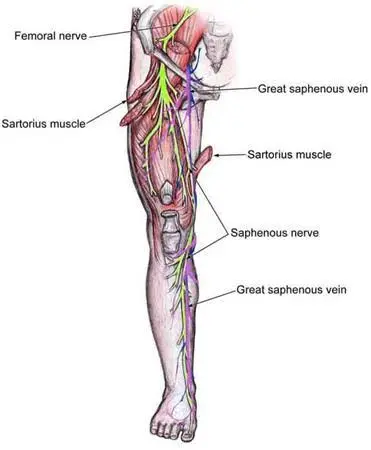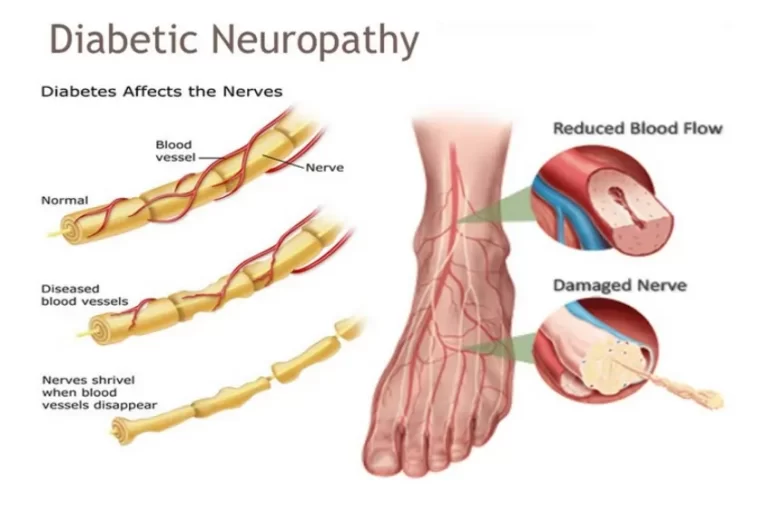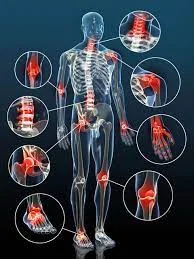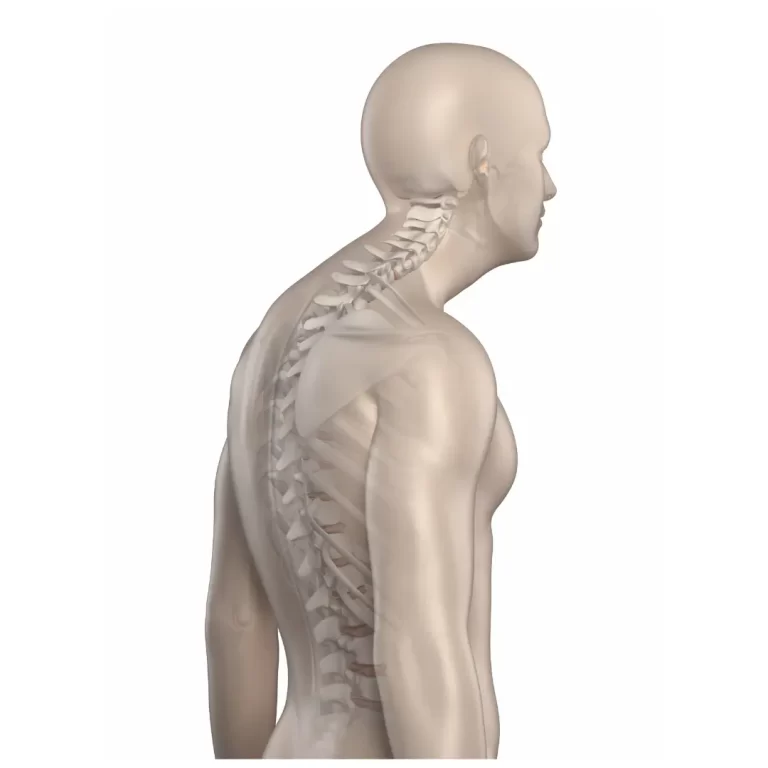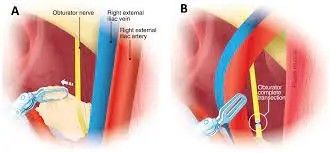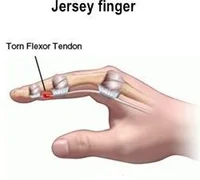Femoral Neuropathy
What is a Femoral Neuropathy?
Femoral neuropathy refers to damage or dysfunction of the femoral nerve, a major nerve in the leg that originates from the lumbar plexus of the lower back (specifically from the second, third, and fourth lumbar nerves).
The femoral nerve is one of the biggest nerves in the body. It begins in the pelvis and divides into several smaller branches. These nerve branches regulate several leg muscles.
The femoral nerve is principally responsible for controlling the muscles of the thigh, as well as knee extension and hip flexion. Additionally, when pressure is applied to the inner calf or thigh, it gets signals from the skin.
Damage to the femoral nerve can happen after hip replacement surgery, even though medical doctors believe femoral neuropathy is rare. It might also be a side effect of diabetes or another medical condition.
The causes, signs, and treatments of femoral neuropathy are covered in this article.
What is the femoral nerve? Anatomy and its Function
- Within the leg, the femoral nerve is one of the biggest nerves. Its motor function allows you to move your feet, ankles, legs, and hips with assistance. It also helps with touch, discomfort, and temperature perception (hot or cold).
The peripheral nervous system includes the femoral nerve. Your brain uses this system to deliver information to your upper, lower, and some organs.
Anatomy of The Femoral Nerve
- The L2 to L4 nerve roots in the lumbar plexus are the source of the femoral nerve. Enters the hollow, wedge-shaped region between the upper thigh and groin known as the femoral triangle.
- This triangle is traversed by the femoral nerve, femoral artery, femoral vein, and lymphatic vessels. Runs between the hip flexor and psoas major muscles along the front of the thigh. Passes by the big blood vessel known as the femoral artery, which supplies blood to the lower limbs.
- Divides beneath the inguinal ligament into the anterior and posterior divisions of nerves. The adductor canal is a small, tunnel-like aperture in the thigh where the posterior division develops into the saphenous nerve. Foot, ankle, lower leg, and knee sensations are supplied by the saphenous nerve.
Function of The Femoral Nerve
- One of the two main nerves that provide the lower limbs with motor (movement) and sensory activities is the femoral nerve.
- The sciatic nerve supplies the rear of the leg, whereas the femoral nerve supplies the front.
- The femoral nerve provides stimulation to the iliacus and psoas major thigh and hip flexor muscles, which enable you to bend, straighten, and bend at the hip. Provides the hip, thigh, knee, and leg with touch, pain, and temperature sensations.
Branches of The Femoral Nerve
- The femoral nerve splits into the anterior (superficial) and posterior (deep) femoral nerves close to the pubic bone. Certain motor or sensory functions are provided by each of these branches:
- Sensory functions: The front and middle portions of your thigh receive sensory signals from the anterior femoral nerve. Your lower leg and foot receive sensory input from the saphenous nerve, which develops from the posterior femoral nerve.
- Motor functions: Your hip flexion and movement are facilitated by the anterior femoral branch. Your quadriceps muscles are under the supervision of the posterior femoral branch, which aids in knee straightening.
What is the Femoral Neuropathy?
- Femoral neuropathy, or femoral nerve dysfunction, is a condition that affects mobility and feeling in a region of the leg and is caused by injury to the nerves, specifically the femoral nerve. This could be the result of a chronic nerve strain, a sickness, or an accident.
- The femoral nerve is the biggest of the five nerve branches that comprise the lumbar plexus. This neural network is found in the body’s lower back, or abdomen. The femoral nerves on either side of your body allow you to bend and straighten your hips and knees.
- It also sends sensations of touch, temperature, and discomfort from your legs to your brain. Without therapy, this condition will usually go away. However, if symptoms don’t go better, prescription drugs and physical treatment can be required.
Causes of the Femoral Neuropathy
A heavy toolbelt around the waist or tight clothing can cause issues for the lateral femoral cutaneous nerve. Additional potential reasons include:
- Trauma and accidents.
- Fractured hip, leg, or pressure from a splint or cast.
- Complications result from femoral artery catheterization procedures or surgical procedures such as hip replacement or hysterectomy.
- Diabetes.
- Herniated Disc
- Infections.
- Persistent nerve pressure, occasionally brought on by obesity or pregnancy.
- Radiation therapy.
- Hemorrhages (blood leaking outside of blood vessels beneath the skin), tumors, or cysts.
Symptoms of the Femoral Neuropathy
The primary symptoms are weakness or paralysis in the front of the thigh, which is supplied with movement and sensation by this nerve. The following are typical signs of femoral neuropathy:
- Sensation variations in the leg, knee, or thigh: These may include pain, tingling, burning, or diminished feeling.
- Leg or knee weakness might manifest as trouble climbing and descending stairs, particularly the lower ones, and as a sensation of the knee buckling or giving way.
- Reduced size of the quadriceps muscles: The front thigh muscles are known as the quadriceps. These muscles may weaken and shrink if the femoral nerve is injured.
Femoral neuropathy occasionally also results in:
- Hip pains
- Discomfort in the groin
- Having trouble bending the hip
Risk factors of Femoral Neuropathy
The following are a few femoral neuropathy risk factors:
- Obesity: Carrying too much weight strains the nerves, especially the femoral nerve. This may result in nerve compression and injury. By following a balanced diet and exercise routine, you can lower your chance of developing femoral neuropathy.
- Diabetes: Elevated blood sugar can harm all of the body’s nerves, including the femoral nerve. Diabetes raises the possibility of femoral neuropathy in patients. To reduce the risk, diabetes must be properly managed, which includes blood sugar control and routine check-ups with a healthcare professional.
- Trauma: Direct injuries to the hip or thigh have the potential to harm the femoral nerve. This could result from a car crash, a fall, or another stressful experience.
- Femur fracture: The femoral nerve may be compressed or injured by a pelvic fracture.
- Extended pressure on the nerve: The femoral nerve can be harmed by sitting or laying in a position that applies pressure to it for an extended length of time. This could happen, for instance, if you wear a tight belt or are bedridden for a long time.
- Surgery: You run a higher chance of developing femoral neuropathy if you undergo certain surgical procedures, such as hip replacement or abdominal surgery.
- specific medical disorders: Femoral neuropathy can also be brought on by illnesses like Guillain-Barre syndrome, an uncommon autoimmune disease that targets the nerves.
- Electrolyte imbalance: Nerve injury and an increased risk of femoral neuropathy can result from electrolyte abnormalities, such as a vitamin B12 deficiency.
It is critical to seek a medical diagnosis and treatment if you think you could have femoral neuropathy.
Diagnosis of the Femoral Neuropathy
To identify femoral nerve dysfunction, your physician might:
- Get a full medical history.
- Do a physical examination of you
- To find out how well your afflicted muscles and nerves work, order an electromyography.
- To evaluate the function of certain nerves, do nerve conduction tests.
- To check for tumors or damage, order an MRI.
Medical History:
- Inquiries concerning the location, intensity, and length of any pain, numbness, or weakness will be asked in-depth by your physician. They will also ask about any recent operations, injuries, or illnesses you may have that could be related.
Physical Examination:
- Your doctor will evaluate your muscular strength, reflexes, and sensation in the leg that is affected during this examination. They will also search for any indications of soreness or swelling in the groin or thigh region.
Diagnostic procedures:
- Nerve Conduction Studies (NCS) and Electromyography (EMG): Your muscles and nerves’ electrical activity is measured by these tests. Whereas NCS measures the speed at which electrical signals pass through your nerves, EMG can identify anomalies in muscle function brought on by injury to your nerves.
- Imaging Examinations: Any underlying conditions that may be causing nerve compression, such as tumors, herniated discs, or abnormalities in the bone, can be found using imaging tests like CT or MRI scans.
In certain circumstances, more testing can be required, including:
- Tests on the blood: To look for vitamin deficiencies, diabetes, or other illnesses that may be linked to neuropathy.
- X-rays: To rule out abnormalities of the bones, such as fractures.
Differential Diagnosis of the Femoral Neuropathy
Differentiating between femoral neuropathy and other disorders is essential for the right course of treatment because these conditions can have similar symptoms. A physician may rule out the following illnesses while making a diagnosis of femoral neuropathy:
Musculoskeletal Disorders:
- Lumbar Radiculopathy (Sciatica): Compression of a lower back nerve root results in lumbar radiculopathy (sciatica), which causes comparable symptoms such as pain, numbness, and weakness but frequently radiates down the rear of the leg as opposed to the front. Differentiating between the two may be aided by a thorough examination to determine the site of numbness and weakness.
- Hip Arthritis: Hip arthritis pain and stiffness might occasionally resemble femoral neuropathy weakness or gait problems. Imaging tests such as X-rays can assist in differentiating between the two.
- Muscle Strain or Tear: Weakness and trouble bending the knee might result from a strained or torn quadriceps muscle. Muscle damage and nerve damage can be different from one another with the aid of a physical examination and possible imaging testing.
Vascular Disorders:
- Diabetic superficial thrombophilia: Pain, swelling, and discomfort in the thigh caused by inflammation of a superficial vein might be misdiagnosed as femoral neuropathy. On the other hand, the inflammatory vein is typically where the symptoms of superficial thrombophlebitis are localized.
Additional neurological disorders:
- Meralgia Paresthetica: This disorder affects a separate femoral nerve branch, resulting in numbness and searing sensation in the outer thigh. It can be distinguished from femoral neuropathy by its precise location.
- Plexopathy: Similar symptoms to femoral neuropathy can be caused by damage to a group of nerves in the pelvis or groin. However, since plexopathy sometimes affects more than one nerve, the range of paralysis and sensory loss it causes is greater.
- Finding the source of your symptoms is essential to receiving the best possible care. To determine the most likely diagnosis, a doctor will take into account your medical history, symptoms, and the outcomes of different tests.
Treatment of the Femoral Neuropathy
Finding the source of your symptoms is essential to receiving the best possible treatment. To determine the most likely diagnosis, a doctor will take into account your medical history, symptoms, and the outcomes of different tests.
The underlying source of the nerve injury determines the course of treatment for femoral neuropathy.
Dealing with the Root Cause:
- The first step is to treat any underlying conditions that may be causing the neuropathy, such as diabetes or vitamin deficiencies. Improving vitamin inadequacies or controlling blood sugar levels in diabetics can enhance nerve function.
- Relieving pressure can help the nerve heal when compressions such as that caused by a tumor or tight clothing are the cause.
General Approaches to Treatment:
- Medication: Several medications, such as the following, can be used to treat the symptoms of femoral neuropathy:
- Painkillers: Acetaminophen or ibuprofen, two over-the-counter pain medications, can help control pain.
- Neuropathic painkillers: Medications such as amitriptyline, gabapentin, or pregabalin may be used for pain that is particular to a nerve.
- Corticosteroid injections: These help relieve pain and reduce inflammation surrounding the damaged nerve.
Physical Therapy:
- Regaining strength and movement in the injured leg is greatly aided by physical therapy.
- Exercises can focus on To enhance stability and function, exercises may concentrate on strengthening the muscles surrounding the hips and knees.
- Extending tense muscles that may be putting pressure on the nerve.
- Enhancing an individual’s walk, or walking style, to avoid accidents or falls.
Lifestyle Adjustments:
- A few adjustments to one’s way of living can help someone heal and stop additional damage:
- Sustaining an appropriate weight: Losing extra weight can relieve nerve pressure and enhance general health.
- Steer clear of activities that exacerbate symptoms: Avoid engaging in activities that put continuous pressure on the femoral nerve, such as wearing tight clothing or adopting particular sitting postures.
- Supplements: To address deficiencies that lead to neuropathy, it may occasionally be advised to take vitamin B12 or other supplements.
Physical Therapy for Femoral Neuropathy
An essential component of the treatment for femoral neuropathy is physical therapy. A physical therapist can create a customized workout plan to help you with your symptoms and restore your leg’s strength, flexibility, and range of motion.
The following are a few goals for physical therapy for femoral neuropathy:
- Diminish discomfort and swelling
- Enhance the function and strength of your muscles.
- Enhance range of motion and flexibility
- Stop the atrophy of your muscles.
- Increase balance and gait
Exercises for the Femoral Neuropathy
The following exercise regimens are frequently used to treat femoral neuropathy:
Stretching: Stretching can assist in releasing tense muscles that can pressure the femur nerve. The following stretches might be useful:
- Hip Flexors Stretch: Stretch your hip flexors by bending on one knee and placing your other foot flat on the ground behind you. Till the front of your hip stretches, gently lean forward.
- Hip Abduction Stretch: Stretch your hip abduction by lying on your side with your knees bent and your hips stacked. Maintaining your ankle stack, raise the upper knee away from the body.
Nerve glides: These soft motions can enhance the femoral nerve’s range of motion. You can learn particular nerve glide exercises from a physical therapist.
Strengthening: To support the hip joint and relieve strain on the nerve, strengthen the muscles surrounding it. Here are a few activities that could be beneficial:
- Hip bridges: Lay flat on your back with your feet flat on the ground and your knees bent. Raise your hips off the floor so that your shoulders to knees are in a straight line.
- Short Leg Raise: Simple leg lifts involve lying on your back with one leg straight and the other bent. Raise the straight leg a few inches off the floor, then hold it there for a short while. Continue with the opposite leg.
Here are some other things to keep in mind:
- As tolerated, begin cautiously and progressively increase the duration and intensity of your workouts.
- Any workout that hurts should be stopped.
- Have patience. You might need to give your fitness program some time before you see the effects.
- Never forget that, particularly if you have femoral neuropathy, seeing a healthcare provider is essential before beginning any fitness program. They can design a safe and efficient approach specifically for you.
Surgery
Surgery is usually reserved for extreme cases, such as when no other options are left to relieve extreme discomfort or profound weakness. The procedure may entail cutting off a tumor that is pushing on the nerve or fixing trauma-related damage.
Complications of Femoral Neuropathy
The following are a few possible femoral neuropathy side effects:
- Permanent nerve damage: The femoral nerve may not fully recover if it has significant damage. This may result in the afflicted leg developing persistent discomfort, weakness, or numbness.
- Muscle atrophy: The femoral nerve’s controlled muscles may atrophy from inactivity. Stair climbing and walking may become challenging as a result.
- Falls: Leg weakness may make a person more vulnerable to falls.
- Skin ulcers: It may be difficult to feel wounds like cuts or burns if there is a loss of feeling in the leg. Skin ulcers, which are open sores with a poor healing rate, may result from this.
- These consequences can be avoided by treating femoral neuropathy as soon as possible.
Prevention of the Femoral Neuropathy
Although there is no surefire method to completely prevent femoral neuropathy, you can greatly lower your risk by making the following lifestyle adjustments:
- Sustain a healthy weight: Being overweight strains the nerves, which raises the risk of injury. You can control your weight with a balanced diet and regular exercise.
- Don’t apply pressure on your thighs for too long: The femoral nerve may be compressed by wearing tight clothing or by spending a lot of time sitting with your legs crossed. If you must sit for extended periods, stand up and walk around frequently during your breaks.
- Keep your posture straight: slouching can make you feel more anxious. With your shoulders back and your core tight, assume a tall stance.
- Handle underlying medical issues: Diabetes and other illnesses can raise your chance of developing femoral neuropathy. You can aid in the preservation of your nerves by appropriately treating these ailments.
FAQs
What is the treatment for femoral neuropathy?
As previously mentioned, physical therapy, avoiding severe hip abduction and external rotation, and knee bracing to prevent knee buckling can be the conservative treatment options for the majority of individuals with femoral mononeuropathy. Neuropathic painkillers may help treat painful femoral neuropathy.
Which symptoms indicate a potential neuropathy?
Peripheral neuropathy symptoms could include the gradual onset of tingling, prickling, or numbness in your hands or feet. Your arms and legs may start to feel the same way. PAIN that is scorching, throbbing, jabbing, or sharp.
With pain in the femoral nerve, can you walk?
This big nerve, which originates in your groin, spreads out to regulate your leg muscles. Feelings in your foot and leg may be affected if this nerve is damaged. It may also have an impact on your gait.
What’s the healing time of a femoral nerve?
This will rely on several variables, such as your ability to adhere to your rehabilitation plan, the stage of your injury, medical and lifestyle concerns, etc. A full recovery often occurs in three to six months after the initial two to three-month period.
What is neuropathy’s underlying cause?
Alcoholism, exposure to pollutants, and nutritional or vitamin imbalances can all harm nerves and result in neuropathy.
What drug is prescribed for neuropathy of the femur?
Certain drugs are used on-label when femoral neuropathic pain is associated with diabetic neuropathy. Pregabalin, gabapentin, amitriptyline, and duloxetine are antidepressants and anticonvulsants that are used to treat neuropathic pain.
References
- Delgado, A. (2018, September 17). Femoral neuropathy. Healthline. https://www.healthline.com/health/femoral-nerve-dysfunction#symptoms
- WebMD Editorial Contributors. (2021, April 16). What to know about femoral neuropathy. WebMD. https://www.webmd.com/diabetes/what-to-know-about-femoral-neuropathy
- Eske, J. (2023, February 9). What to know about femoral neuropathy. https://www.medicalnewstoday.com/articles/324084#speaking-with-a-doctor
- Femoral nerve dysfunction. (n.d.). Mount Sinai Health System. https://www.mountsinai.org/health-library/diseases-conditions/femoral-nerve-dysfunction
- Femoral nerve. (n.d.). Physiopedia. https://www.physio-pedia.com/Femoral_Nerve
- Professional, C. C. M. (n.d.-e). Femoral nerve. Although peripheral neuropathy is typically incurable, there are a few strategies to prevent further progression. Before addressing any underlying medical concerns, such as diabetes, your healthcare provider will treat the pain and other symptoms of neuropathy. eland Clinic. https://my.clevelandclinic.org/health/body/21786-femoral-nerve
- Femoral neuropathy: Causes, Risk Factors, Symptoms, Treatment. (n.d.). https://continentalhospitals.com/diseases/femoral-neuropathy/

